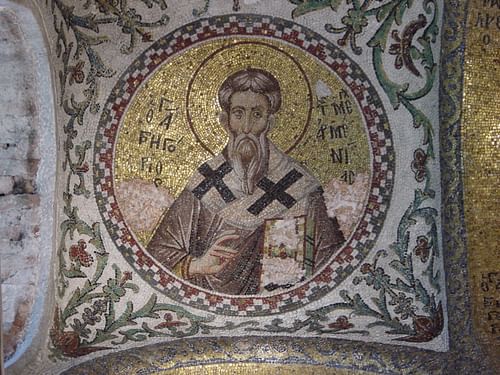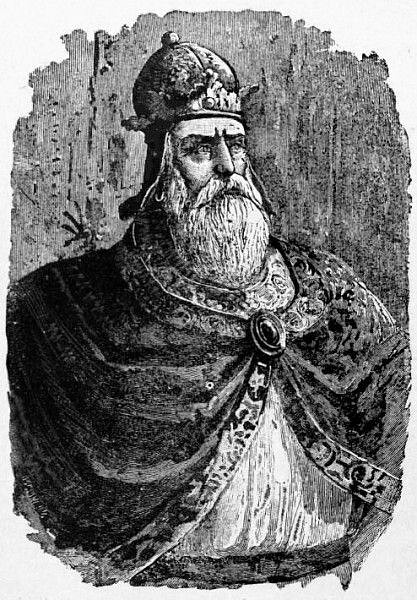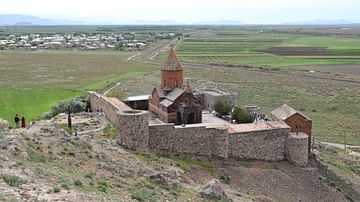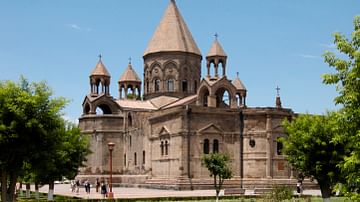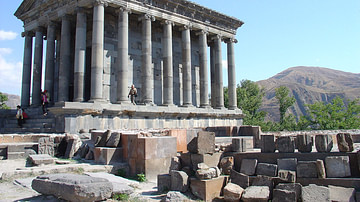The Christianization of Armenia began with the work of Syrian apostles from the 1st century CE and was boosted in the early 4th century CE by such figures as Saint Gregory the Illuminator, who converted the Armenian king and spread the gospel message. A more complex process than legendary accounts portray, Armenia's adoption of Christianity was, nevertheless, a momentous chapter in the country's history, as the historian R. G. Hovannisian here explains:
The conversion of Armenia to Christianity was probably the most crucial step in its history. It turned Armenia sharply away from its Iranian past and stamped it for centuries with an intrinsic character as clear to the native population as to those outside its borders, who identified Armenia almost at once as the first state to adopt Christianity. (81)
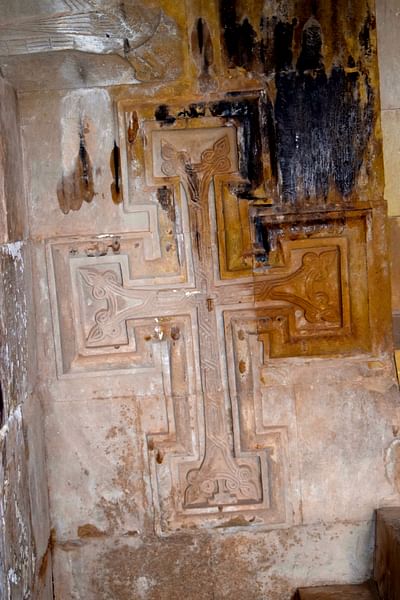
The Legend: Saint Gregory the Illuminator
The credit for establishing Christianity as the official religion of ancient Armenia is traditionally given to Saint Gregory the Illuminator or Enlightener (previously known as Grigor Lusavorich, c. 239 - c. 330 CE). Gregory is credited with converting king Tiridates the Great (r. c. 298 to c. 330 CE) to the new religion, formally establishing the Armenian Church, and spreading Christianity throughout his country. For these achievements, Saint Gregory has become the patron saint of Armenia.
Gregory was born in Cappadocia and raised as a Christian, attending there a Greek Christian school. On returning to Armenia, Gregory gained a position as a palace functionary at the court of the Armenian king at Vagharshapat. There he made a stance against the pagan religion of the period and refused to participate in its rites. The reigning monarch was Tiridates the Great, and he had the troublesome Gregory imprisoned, tortured, and thrown into the terrible Khor Virap prison at Artashat. Known as the “pit of oblivion”, nobody ever returned from Khor Virap.
After a 13-year ordeal down in the pit, Gregory was given a miraculous lifeline by, of all people, Tiridates' sister Khosrovidukht. She had had a vision that Gregory was the only person who could save the king from his terrible illness (lycanthropy). Accordingly, Gregory was freed from Khor Virap, and naturally, besides trying to cure the king, he made his best efforts to convert him to Christianity. Tradition (and the Armenian Apostolic Church) records that Tiridates was indeed cured and converted to his new faith in 301 CE by Saint Gregory.
Gregory was then made the first bishop (katholikos) in Armenia's history c. 314 CE, and he set about formally establishing the Christian Church. To get the ball rolling, Tiridates gave Saint Gregory up to 15 provinces worth of territory to establish the Armenian Church. The old pagan temples were torn down, and the whole nation was obliged to embrace the new faith. Churches and monasteries sprang up everywhere, and the Armenian aristocracy quickly followed the royal family's example with many noble families converting to Christianity.
Saint Gregory, then, had state backing to spread the Gospel message, and it was a work continued by his descendants who inherited the role of first bishop of Armenia. Gregory used two powerful tools to spread the word: education and military power. Schools were established in which children of the existing pagan priestly class were prepared for the Christian priesthood. Meanwhile, military units were dispatched to destroy pagan temple sites and confiscate their vast riches, which were then used to fund Christian building projects. Naturally, many temple sites, along with several rich and semi-independent feudal principalities, resisted the new policy and these were put to the sword. Pagan traditions were never fully eradicated but they certainly became weakened by the removal of the temples and their economic resources. Still, many anti-Christian and pro-Persian aristocratic families persisted in resisting at least into the next century. Gregory, meanwhile, oversaw mass baptisms in the Euphrates River; bishops were then appointed from the noble clans (nakharars) and lower priests from the class of knights (azats) to guide the ever-growing flock of faithful.
The History: A Gradual Adoption
That is the legend of how Armenia became a Christian state. Modern historians, though, prefer a more organic process of acceptance and conversion occurring in different places at different times. They also prefer the more secure date of around 314 CE of Armenian's official adoption of Christianity. This followed the Roman emperor Constantine I's Edict of Milan in 313 CE which legalised Christianity in the Roman Empire of which Armenia was a province. It seems probable that Christianity actually entered Armenia by two separate but more or less contemporary routes, thus explaining the conflicting accounts in ancient historical records.
Saint Gregory represented the transmission via Greek culture in the capital while in the provinces a greater influence came from Syria, especially via the Armenian communities in the cities of Mtsbin and Edessa in Mesopotamia. Edessa, in particular, following the work of the two apostles Thaddeus and Bartholomew, was a major centre of the faith. With a large Armenian population and the religion having there been established for over two centuries, it is probable that returning emigrants brought Christianity back with them. Indeed, both of the aforementioned apostles travelled to Armenia, as did many Assyrian priests such as Bardatsan (Bardaisan) of Edessa, and there set up schools which taught and preached the new faith. Another route into Armenia of Christian ideas was via the border regions of Bitlis (Baghesh) and Mush (Taron) to the west of Lake Van. Thus, the spread of the religion was much slower and more haphazard than in the traditional account.
Historians also suggest that Tiridates the Great may well have adopted Christianity for more practical reasons than a change of faith based on his miraculous recovery of health. The end of the ancient pagan religion was a fine excuse to confiscate the old temple treasuries which were jealously guarded by a hereditary class of priests. The religion was also a useful point of distinction between Armenia and Sasanid Persia, who had been trying to spread Zoroastrianism in the country. Christianity, therefore, became a means to resist Iranian cultural imperialism.
At the same time, Rome, the other regional power seeking to control Armenia, saw the value in permitting the spread of Christianity as a means to maintain Armenia's independence from Persia. Finally, a monotheistic religion with the monarch as God's representative on earth might well instil greater loyalties from his nobles and people in general. As it turned out, the Armenian Church became an independent institution with noble families providing its key figures and monasteries able to achieve self-sufficiency through their own landed estates.
Two Christianities
As we have seen Christianity entered Armenia and spread outwards via two principal routes, from the southern provinces northwards and from the capital outwards. To further complicate matters, there were also two variants of the faith, as here explained by the historian S. Payaslian:
The southern Armenian form of Christianity was oriented more toward the masses, espoused more democratic ecclesiastical principles and communal philosophy, and was therefore less amenable to rigid institutional hierarchy…but it was the western, Greco-Roman form of Christianity, which entered Armenia by way of Cappadocia, that superseded the southern church and established its ecclesiastical hegemony in Armenia. (35)
Saint Gregory, was, of course, an exponent of the western form of the faith.
SOCIAL CHANGES
For ordinary people, besides the obvious replacement of traditional gods and pagan temples, there were also social changes which directly affected them. One notable area was marriage as the Christian church formalised the institution and made it necessary for the couple to legalise their union through the swearing of vows which adhered to the Christian doctrine. Even the choice of partner was more limited as partners now had to come from outside one's family with the exception that a widow might marry her brother-in-law. Polygamy, which had not been uncommon, was also prohibited. Other traditional rituals which were now forbidden included lamentations for the dead and mourning dances during which mourners often cut their faces and arms. The Church brought benefits as well as restrictions, though, setting up hospitals, hostels, orphanages, and leprosaria for the poor and sick.
Mesrop Mashtots & the Armenian Alphabet
By the early 5th century CE Christianity in Armenia was given a great boost by the invention of the Armenian alphabet by the scholar-clergyman Mesrop Mashtots (360/370 - c. 440 CE). Mashtots, with full state and church backing, created a new script with the primary purpose of allowing the common people to read the Bible and other Christian texts in their own spoken language, which at that time had no written form. The ultimate consequence of this approach to spreading the gospel through language is here summarised by S. Payaslian:
The following years witnessed enormous efforts by learned religious leaders and scholars to translate Greek and Syriac Christian texts into Armenian and to strengthen the new national culture through Armenianization. The church gradually gained control over Armenian culture, literature and education and, with the support of the state, instituted a Christian hegemonic, “totalising discourse”. Armenian culture, identity, and history came to be viewed nearly exclusively through the prism of Christian theology. (40)
This article was made possible with generous support from the National Association for Armenian Studies and Research and the Knights of Vartan Fund for Armenian Studies.
